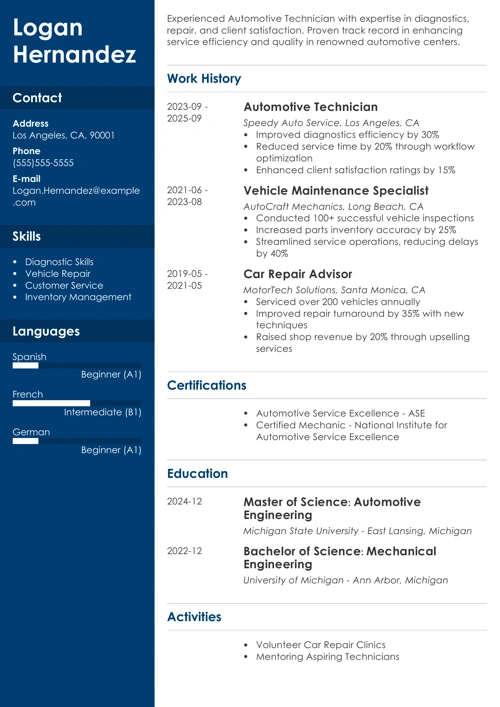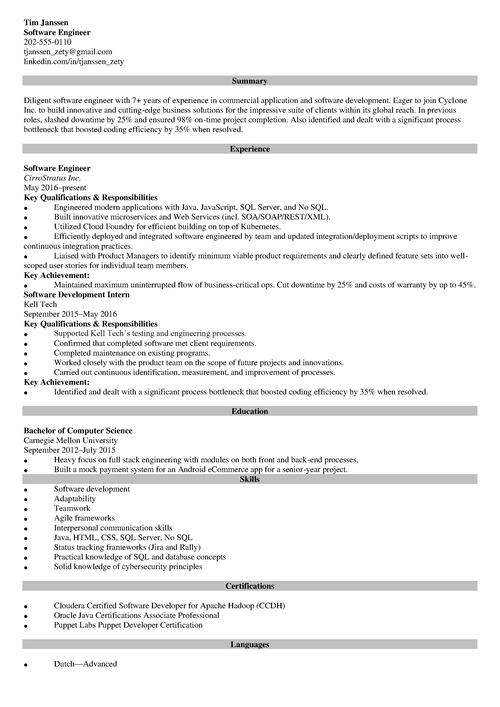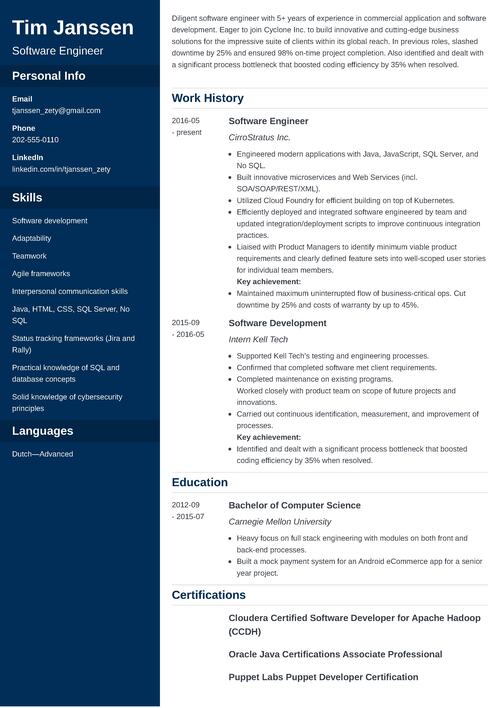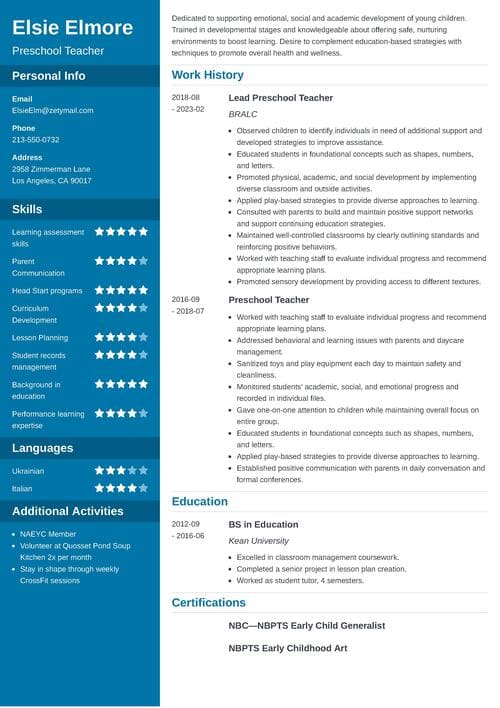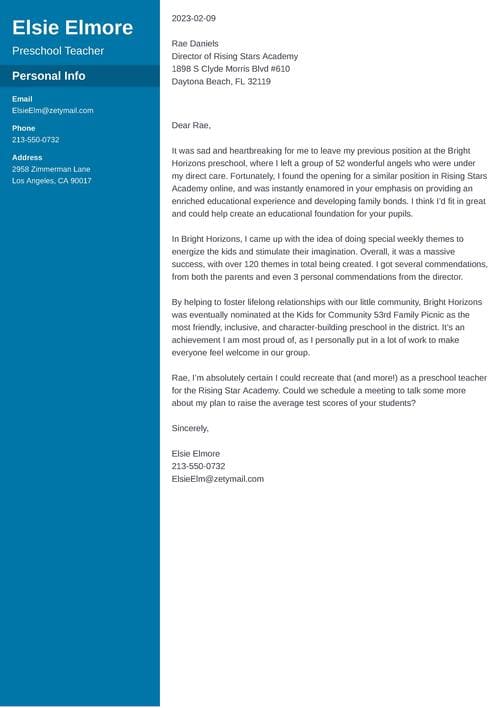The job market is changing fast—and it's not slowing down. New technology, particularly AI, is transforming the way we work. To keep up, grow, and avoid falling behind, one thing matters more than ever: learning new skills.
That's where upskilling comes in. It's not just about staying current—it's about taking control of your future. Whether you're seeking a new job, aiming for a promotion, or looking to future-proof your career, upskilling can help you achieve your goals.
Want to save time and have your resume ready in 5 minutes? Try our resume builder. It’s fast and easy to use. Plus, you’ll get ready-made content to add with one click. See 20+ resume templates and create your resume here.
Sample resume made with our builder—See more resume examples here.
One of our users, Brittanya, had this to say:
Zety really helped me create the best resume possible. It pointed out how things could be better on my existing resume and suggested many things to be re-worded or removed.
What Is Upskilling?
Upskilling refers to learning new skills to stay updated with changes in your job or industry. It could be something big, like mastering a new software, or something small, like improving your communication or time management. The goal is simple: stay sharp, stay relevant, and keep moving forward in your career.
According to the World Economic Forum, 39% of today’s skills are expected to be outdated by 2030. That’s nearly two out of every five. The workplace is evolving, and to stay ahead, you’ll need to continue learning. Upskilling helps you stay ahead of the curve, stand out to employers, and future-proof your career.
How Upskilling Can Boost Your Career
Learning new skills doesn't just help you keep up; it helps you move up. When you upskill, you make yourself more valuable in the job market. You show employers that you're flexible, motivated, and ready to take on new challenges.
Here's how upskilling can benefit your career:
- Better job opportunities: Employers are more likely to notice candidates who stay current and show a willingness to learn.
- Higher pay: The more skills you bring to the table, the more value you offer, often leading to increased income.
- Career advancement: Upskilling prepares you for promotions, leadership roles, or more specialized positions.
- More confidence and flexibility: Learning new things gives you the freedom to try different roles or career paths.
- Stronger job security: When the job market shifts or tech changes, your skills help you stay relevant and protect your future.
How to Future-Proof Your Career: 5 Upskilling Strategies
If you want to stay ahead in your career, learning new skills isn’t just a one-time thing; it’s something you keep doing. These five simple strategies can help you build useful skills and prepare for whatever comes next.
1. Identify skill gaps
Start by figuring out what skills you’re missing:
- Look at job listings for the kind of role you want. What skills do they ask for?
- Ask your manager or mentor what you could improve.
- Consider your current tasks: what slows you down or feels unfamiliar?
Once you know where the gaps are, you can focus on closing them.
2. Create a plan
You know what skills you need, it’s time to make a plan. Upskilling works best when you treat it like a real goal, with specific steps to achieve it.
Start by setting SMART goals. That means your goal should be:
- Specific: Clear and focused
- Measurable: You can track your progress
- Achievable: Realistic for your time and skill level
- Relevant: Connected to your career goals
- Time-bound: Has a deadline
For example, instead of saying, “I want to learn Excel,” try: “I’ll complete a beginner Excel course on LinkedIn Learning in the next three weeks by practicing 20 minutes a day.”
Once you have a SMART goal, build a simple routine:
- Set aside regular time for learning. Identify a time that works for you, such as before work, during lunch, or on weekends.
- Write down your goals. Take action, record your progress, and check in weekly to stay on track.
- Stay flexible. If something isn’t working, adjust your plan.
Even small steps each week can lead to significant progress over time.
3. Try different types of learning
Everyone learns differently, and you don't need to commit to just one option. Try out a few of these options to see what fits your style and schedule:
- Online courses: Digital courses and certifications are great for flexible learning at your own pace. You can try platforms like:
- LinkedIn Learning: Short career-focused courses
- Coursera and edX: College-level content
- Google Career Certificates: Practical, job-ready skills
- Udemy and Skillshare: Affordable courses on a wide range of skills
- Workshops and bootcamps: Short and intense, these programs focus on specific topics, like coding, design, or project management.
- Formal education: Community colleges or universities offer classes for more in-depth learning. Some even have night or weekend programs for working adults.
- Mentorship or apprenticeships: Learning directly from someone with experience can help you grow faster. You can find mentors at work or through professional groups.
- Reading and podcasts: Books, blogs, and podcasts are great for staying up to date and learning on the go.
4. Engage in side projects
One of the best ways to learn is by doing. Side projects give you an opportunity to practice new skills in real-world situations and improve your resume or portfolio.
Here are some ways to get started:
- Personal projects: Create something on your own, like building a website, starting a blog, or designing graphics. These projects show your creativity and drive.
- Volunteer work: Offer your skills to nonprofits or community groups. Volunteer work helps you gain experience and expand your network.
- Freelance or consulting work: Take on small jobs for businesses or individuals. These side jobs let you build professional experience while getting paid.
Side projects let you test what you’re learning, build confidence, and make connections that can help your career grow.
5. Actively seek feedback
You can’t grow if you don’t know what to work on. That’s why asking for feedback is a key part of upskilling. It helps you identify your strengths, correct mistakes, and continue improving over time.
Here’s how to get helpful feedback:
- Ask for input: Reach out to your manager, coworkers, or mentors for their perspective. A simple question like “How can I improve on this?” can open the door to helpful advice.
- Join professional communities: Look for online forums, Slack groups, or local meetups in your field. These spaces let you ask questions, get tips, and learn from others.
- Attend industry events: Conferences, workshops, and webinars can expose you to new ideas and give you a chance to connect with experts.
- Use peer reviews or practice groups: Sharing your work with others, even informally, can help you spot areas for growth.
Creating a resume with our builder is incredibly simple. Follow our step-by-step guide and use content from Certified Professional Resume Writers to have a resume ready in minutes.
When you’re done, Zety’s resume builder will score your resume and our resume checker will tell you exactly how to make it better.
Navigating the AI Era: AI-Proof Careers
AI is rapidly transforming the way we work. Some tasks that used to take hours can now be done in minutes with the help of innovative tools. While that can make work easier, it also means some jobs are at risk of being replaced or reshaped.
But not all roles are in danger. In fact, many careers are expected to grow, not shrink, in the AI era. Let's review AI in the workplace and how you can navigate this new era:
AI’s impact in the workplace
Artificial intelligence has quickly moved from something we talked about to something we use every day. According to Zety’s AI in the Workplace Report, more workers have started using AI tools to do everything from writing emails to analyzing data; 71% to be exact. It’s becoming a normal part of the workday—and it’s changing how jobs get done.
While AI can make work faster and easier, it’s also creating challenges. One in four workers has already lost their jobs due to automation, and many more are wondering if their roles could be next. The fear of being replaced is real—but so is the drive to stay ahead.
That’s why workers are stepping up. Zety’s Future of Work 2025 Survey reported that 95% of employees are already taking steps to develop their AI skills through training, self-study, or hands-on practice. Upskilling is no longer optional. It’s one of the best ways to stay competitive and future-proof your career in a fast-changing world.
What makes a job AI-proof
As AI tools become more powerful, many tasks, especially repetitive or rule-based ones, can be done by machines. But not everything can be automated. Some jobs are much harder for AI to replace because they rely on deeply human skills.
Here are some examples of soft skills that make a job more “AI-proof”:
- Creativity: AI can copy or remix ideas, but it can’t create something truly original. Jobs that involve design, writing, storytelling, or innovation still need a human touch.
- Critical thinking: AI can process data, but it doesn’t understand context like people do. Problem-solving, analyzing complex situations, and making good decisions are skills that humans do best.
- Emotional intelligence: Machines can’t truly understand emotions. Jobs that involve listening, caring, and working closely with others, like teaching, social work, or nursing, are harder to automate.
- Strategic thinking: Long-term planning, making judgment calls, or leading through uncertainty requires big-picture thinking that AI can’t replicate.
- Leadership: Inspiring a team, managing conflict, and making values-based decisions all depend on human connection and experience.
These are some hard skills that help make a job more AI-proof:
- Technical proficiency: Jobs that require handling medical devices, electrical equipment, or kitchen appliances need hands-on know-how that only humans can provide.
- Manual dexterity: Tasks that need steady, skilled hands, like helping patients recover, caring for animals, or fixing electrical systems, depend on human skill.
- Safety and compliance: Following safety rules and legal guidelines requires careful attention and judgment. Machines can’t fully understand when or how to apply these rules in every situation.
- Hands-on troubleshooting: When things go wrong, solving problems quickly often means using experience and practical skills in real time—something AI can’t easily do on the spot.
- Data interpretation and documentation: While AI can process data, understanding what it means and recording it accurately in the right way needs human judgment and care.
10 AI-proof jobs
Some careers are much harder to automate than others. These roles rely on human skills like empathy, hands-on care, creativity, and real-time problem-solving, things AI can’t easily copy.
Here are 10 AI-proof careers to consider:
- Electricians: This job requires hands-on work, quick thinking, and adapting to different situations on-site—skills that are tough for machines to handle.
- Flight attendants: Safety, communication, and helping passengers in real time are key parts of this job. It depends on human judgment and emotional awareness.
- Head chefs: Head chefs manage a team of cooks, make fast decisions under pressure, and bring a personal touch to every dish, things AI can’t replace.
- Mental health counselors: AI can’t fully understand human emotions or provide the deep, personal support that therapy requires.
- Nurse practitioners: This role combines medical knowledge with care and empathy. Treating patients goes far beyond just following data.
- Nutritionists: Helping people improve their health through food involves listening, customizing advice, and building confidence—all human skills.
- Physical therapists: Guiding patients through recovery takes hands-on work, encouragement, and adjusting to each person’s needs.
- Social workers: Supporting people through tough times requires emotional intelligence, real-life experience, and strong communication skills.
- Teachers: While AI can provide information, teaching is about connecting with students, adapting to their needs, and inspiring growth.
- Veterinarians: Caring for animals means using both science and instinct. Diagnosing and treating pets is complex and hands-on.
Presenting Your New Skills in Your Job Application
Upskilling is only half the battle. Now it's time to show employers what you've learned. Whether you're updating your resume or writing a cover letter, the way you highlight your new skills can make a big difference.
Let's dive in:
Incorporating new skills into your resume
You've done the work, now make sure your resume reflects it. Here's how to show off your new skills the right way:
- Update your skills section: Add the tools, software, or abilities you've learned. Be specific about your new soft or technical skills (e.g., "SQL" or "Google Analytics" instead of just "data skills").
- Refresh your summary: Use your resume summary to discuss your most recent upskilling efforts, demonstrating your proactive approach.
- Highlight skills in your work experience: Add bullet points that show how you’ve used your new skills in real projects, side jobs, or volunteer work.
- Add a certifications section: If you've earned a certificate from a course or training program, list it clearly—especially if it's job-related.
- Match the job ad: Use keywords from the job description to match your new skills to what employers are looking for and improve your chances of passing applicant tracking systems (ATS).
Crafting a cover letter that shows your new skills
Your cover letter is a great place to talk about how you've grown. Follow these tips to write a cover letter that shows you're a stronger candidate:
- Lead with your strongest skill: Start your letter by highlighting a key skill you've gained and how it connects to the job.
- Give a real example: Show how you've used this skill in a project, class, or side job to make your work experience feel real and relatable.
- Explain why you chose to upskill: A quick sentence about why you wanted to learn something new can show motivation and curiosity.
- Connect your skills to the company's needs: Use the job description to show how your new skills can help the team achieve its goals.
- Close with confidence: Remind the employer how your growth mindset and fresh skills make you an excellent fit for the role.
Want to write your cover letter fast? Use our cover letter builder. Choose from 20+ professional cover letter templates that match your resume. See actionable examples and get expert tips along the way.
Sample cover letter for a resume—See more cover letter examples and create your cover letter here.
One of our users, Nikos, had this to say:
Zety is an excellent resume and cover letter generator with excellent customer service. I love it!
Why a Growth Mindset Helps Lifelong Career Success
In a world where technology and workplaces are changing fast, learning can’t stop when school ends. The people who stay curious, keep growing, and see challenges as chances to improve are the ones who stay ahead.
Taking upskilling courses, learning new tools, and trying fresh ideas aren’t just short-term fixes. These strategies are long-term habits that help you build a strong, flexible career. Whether you’re switching fields, trying to grow in your role, or want to feel more confident at work, continuous learning puts you in control.
Your career is your responsibility. With a growth mindset and the right skills, you can shape your future and be ready for whatever comes next.
Key Takeaways
- Upskilling means learning new skills to stay current in your field. It can help you find better jobs, earn more, and feel more confident about your future.
- 71% of workers are already using AI on the job, and it’s quickly becoming part of everyday work life.
- One in four workers says they’ve already lost a job due to AI, especially those in entry-level positions.
- 95% of employees are already taking action to improve their AI skills through training, self-study, or hands-on learning.
- Roles that require creativity, emotional intelligence, or physical presence are harder for AI to replace.
- Knowing how to operate tools, follow safety rules, and solve hands-on problems adds lasting value to your role.
- Being open to learning new skills and adapting to change helps you stay competitive, regardless of how work evolves.
About Zety’s Editorial Process
This article has been reviewed by our editorial team to make sure it follows Zety's editorial guidelines. We’re committed to sharing our expertise and giving you trustworthy career advice tailored to your needs. High-quality content is what brings over 40 million readers to our site every year. But we don't stop there. Our team conducts original research to understand the job market better, and we pride ourselves on being quoted by top universities and prime media outlets from around the world.
